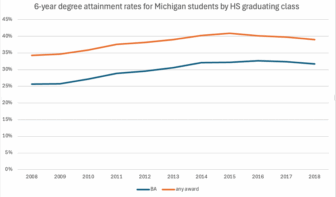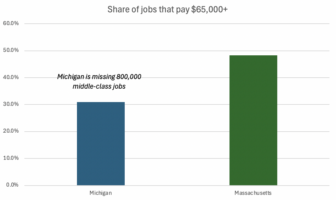Higher education is being assaulted across the country, not just here in Michigan. We have been – to our detriment – cutting higher education funding longer and more than others. But now there is a nationwide campaign to question the value of higher education and particularly to attack public higher education. One part of that attack is that it is inefficient, not run like a business.
A recent Slate article is terrific in making the case that we don’t want our universities run like a business. That the so-called inefficiencies are at the core of what makes our universities so valuable. Before we get to the purported academic inefficiencies that the article is about I want to deal with financial management issues.
Seems to me one can make the case that in managing revenues and expenses Michigan’s public universities are at the leading edge. Largely absent are the chronic deficits that have plagued state government and too many of our local governments and schools districts and their huge legacy cost problems of unfunded pensions and health care for current and future retirees. And where are the bankruptcies and bailouts that characterize too much of Michigan’s private sector?
So if it is not fiscal mismanagement that is the problem, what about the growing chorus that our campus based universities are not providing teaching and learning in the most efficient way. The Slate article uses the University of Virginia to explore this issue. The article’s author is Siva Vaidhyanathan a UVA professor. The article is so good at making the case I have chosen to quote it at length without adding comments. I really recommend that you read the whole article. It is terrific. And hopefully we will learn from what happened at UVA. We too need university leadership, faculty and students to engaged in this fight. Our public higher education system is one of the state’s best assets. It clearly is one of the keys to the state’s future economic success. It is worth fighting for.
Here is what Vaidhyanathan writes:
… We Americans take these institutions for granted. We assume that private enterprise generates what is so casually called “innovation” all by itself. It does not. The Web browser you are using to read this essay was invented at the University of Illinois at Urbana-Champaign. The code that makes this page possible was invented at a publicly funded academic research center in Switzerland. That search engine you use many times a day, Google, was made possible by a grant from the National Science Foundation to support Stanford University. You didn’t get polio in your youth because of research done in the early 1950s at Western Reserve University School of Medicine. California wine is better because of the University of California at Davis. Hollywood movies are better because of UCLA. And your milk was not spoiled this morning because of work done at the University of Wisconsin at Madison.
… We hear every day from higher-education pundits who can’t seem to express themselves in anything other than jargon and buzzwords that American higher education is “unsustainable.” No. It’s just not adequately sustained. There is a big difference. We could choose to invest in people. We could choose to invest in culture. We could choose to invest in science and technology. We choose instead to imagine that there are quick technological fixes or commercial interventions that can “transform” universities into digital diploma mills. Pundits blame professors for fighting “change.” But they ignore the fact that universities are the chief site of innovation and experimentation in digital teaching and research and that professors might actually know what works and what does not.
Instead of holding up their responsibility, states are divesting themselves of the commitment to help their young people achieve social mobility. States are rigging the system so that only the wealthy can compete for slots in the best universities. States shift the cost of higher education from taxpayers—all of whom benefit from living in a wiser, more creative society—to the students themselves. Yet students keep coming, desperate to enter the privileged classes, unable to imagine a different way through a cruel economy that has no use for the uneducated any more.
Universities are supposed to be special places where we let young people imagine a better world. They are supposed to be able to delay the pressures of the daily grind for a few years. They are supposed to be able to aspire to greatness and inspire each other. A tiny few will aspire to be poets. Many more will aspire to be engineers. Some will become both. Along the way they will bond with friends, meet lovers, experience hangovers, make mistakes, and read some mind-blowing books.
Does that sound wasteful? Does that sound inefficient? Nostalgic? Out-of-sync with the times? Damn right it does. But if we don’t want young people of all backgrounds to experiment with ideas and identities because it seems too expensive to support, we have to ask ourselves what sort of society we are trying to become.
Higher education is not one system. There are multiple layers and a wide variety of institutions. But they all have one thing in common: They have a mission to use knowledge to empower people to imagine a better life and transform society. If we like where we are, let’s just forget about it and roll back public support for higher education. But if we aspire to better things as a society, not just as individuals, then we should rediscover the vision of public higher education that inspired the University of Virginia in the first place.






